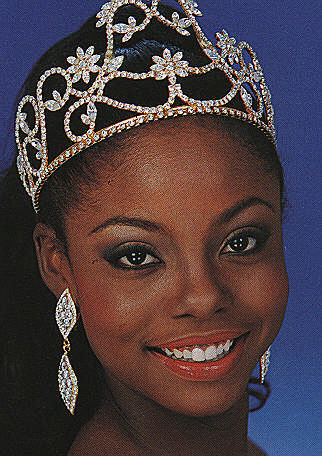“The unity of the West Indies . . . ” This was one of the goals Wendy Fitzwilliam promised to work for as she was acclaimed Miss Universe 1998, in Hawaii on May 12.
Was it irony that her runners-up were from Puerto Rico and Venezuela, two other territories that frame the Caribbean Basin?
The representative from Trinidad and Tobago is the most recent in a succession of Caribbean women to be recognised among the most beautiful in the world. The Miss World title had been won by Jamaica’s Carole Joan Crawford, Cindy Breakspeare and Lisa Hanna, Grenada’s Jennifer Hosten, Guyana’s Shakira Baksh (who later married Michael Caine) and Trinidad and Tobago’s Giselle Laronde. In 1977, Trinidad and Tobago’s Janelle “Penny” Commissiong was crowned the first West Indian Miss Universe. Petite, black, she was not the Universe’s conventional idea of female beauty; it was felt that she had won from sheer bravado and, of course, that dazzlingly seductive smile that sheathes a will of steel. In 1995, that epitome of BWIA’s In-flight Service and Natural Caribbean Warmth, Arlene Peterkin, reached the last six Miss Universe finalists and last year Margot Bourgeois reached the last three.
But Wendy. “Ah Wendy,” says Boscoe Holder, one of the region’s foremost portrait painters, “I’ve known she’s had something special since she was 13 . . . that face, those legs that go on forever . . .” Wendy has sat for numerous Holder paintings, and, for the last decade, he has produced images of West Indian womanhood with Wendy as the matrix.
In 1998, Wendy Fitzwilliam is part of the millennial turn towards a deeper perception of beauty. Pretty’s too plain a word to describe her. “She’s not that pretty!” Miss France proclaimed, in pique. Wendy responded, “She’s entitled to her opinion.” But she sings, jazz with smoky blue notes. And the girl thinks on her feet: the training for her law degree has already paid off. The exams she needs to complete her degree at the University of the West Indies must now be deferred for a year.
At 25, Wendy is no giddy schoolgirl. Life has absorbed her: growing up in the intimacy and security of suburban Diamond Vale; St Joseph’s Convent school days; learning to be a lawyer; modelling for Meiling’s fashion shows as soon as she was tall enough; and she loves to party. As patron of the Cyril Ross Children’s Home for infants who are HIV positive, she has given the gift of time and her loving presence to needy children: “I run and play with them, and sometimes when I get home Mummy wonders where I was, because of the sand and dirt on my clothes.”
Her role model is Audrey Hepburn, she says, whose “extraordinary beauty and grace was reflected in all facets of her life.” Hepburn’s charisma with Iman’s gazelle grace. Wendy’s win has endorsed the West Indian woman as a valid symbol of the diversity of the Universe: cultivated from the races of the world, she still exudes “girl next door.”
Franka Philip, a journalist and Wendy’s contemporary at university, claims: “My second question to Wendy after meeting her was, ‘You ever thought about entering Miss Trinidad and Tobago? You’d make a good Miss Universe!’ Her response was ‘Oh, please . . . ’.” That was at the University of the West Indies, St Augustine, in 1992. More than her six-foot frame, Franka remembers a quirky but defining fashion sense: “One day, she wore a full-length flared dress with Converse sneakers. Cricket games stopped and conversations hung in mid-sentence. Wendy went on her merry way, oblivious to the brief parenthesis she caused in the life of the campus.”
Many an evening, Wendy and her friends Yoshabelle, Leslie and Natasha would “lime” and dance in the Students’ Guild Bar. In fact, says Franka, “Wendy didn’t dance that much — she was too busy laughing at us play the fool on the dance floor. Once, a whole group of us sat in front of the bar, drinking water from white rum bottles. After some time, Wendy became self-conscious: ‘Oh gosh, we have to stop; by now they must think we really drunk!’” Franka is convinced that though she might be “Queen of the Universe”, “she’ll still be the caring, fun-loving Wendy I met six years ago.”
Along with the prizes and presents, the travel and “state visits,” the year for Miss Universe carries responsibilities. It gives her the opportunity to instill “good values by example.” Wendy says, “My goal will be to impress upon women that their struggle should not be for superiority over men, but for equality to fulfil our God-given task of bringing up children, the future of the human race, together.”

















